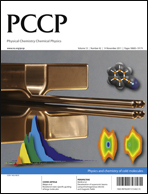Molecular ion–electron recombination in an expanding ultracold neutral plasma of NO+
Abstract
Using state-selected double-resonant excitation, we create a Rydberg gas of NO molecules excited to the principal quantum number n = 50 of the f-series converging to the ion rotational level, N+ = 2. This gas evolves to form an ultracold plasma, which expands under the thermal pressure of its electrons, and dissipates by electron–ion recombination. Under conditions chosen for this experiment, the observed rates of expansion vary with selected plasma density. Electron temperatures derived from these expansion rates vary from Te = 12 K for the highest density up to 16 K at four-fold lower density. Over this range, the apparent electron coupling parameter, defined as Γe = e2/4πε0akBTe, falls from nearly three to about one. The decay of charged-particle density fits with a kinetic model that includes parallel paths of direct two-body and stepwise three-body dissociative recombination. The overall recombinative decay follows a second-order rate law, with an observed rate constant that fits with established scattering-theory estimates for elementary two-body dissociative recombination. A small residual increase in this rate constant with decreasing charged-particle density suggests a growing importance of the three-body recombination channel under conditions of decreasing electron correlation.

- This article is part of the themed collection: Physics and chemistry of cold molecules

 Please wait while we load your content...
Please wait while we load your content...